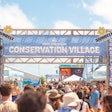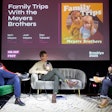The men and women of Washington parted ways last Thursday evening, heading to two separate, (mostly) single-sex fund-raisers where the eye candy was plentiful. The men smoked cigars (thanks to a last-minute smoking waiver), watched some fierce boxing matches, and ogled models, Hooters girls, and nearly naked cheerleaders. The women had their fun, too, kicking back in a South Beach-style lounge and ripping the T-shirts off male models dressed as lifeguards. The two decidedly different events—Fight Night and the Knock Out Abuse Against Women gala—eventually met up for a joint after-party, where Lenny Kravitz performed.
Per tradition, the 18th annual Fight Night indulged masculine fancy, treating its 2,200 guests—music producer Quincy Jones, actor Chris Tucker, and Supreme Court justice Antonin Scalia among them—to a night out with the boys. Held at the Washington Hilton and Towers, the event featured a new branding strategy and a cameo by rocker Ted Nugent, along with the customary parade of boxing legends and revving motorcycle engines.
The biggest challenge this year was the city’s new smoking ban, which threatened a hallmark of Fight Night’s throwback culture. The Hilton and Fight for Children, the charity that puts on the event, applied jointly for a waiver, and late last week it finally came through. “It was certainly stressful not knowing,” said FFC director of external relations Jeff Travers. “We made the case in our application that this was a highly stylized event and that the cigar-smoking was part of that." The waiver allowed guests to smoke only in the main ballroom, so staffers and volunteers put up signs at every exit.The cavernous ballroom was a sensory overload. Smoke swirled throughout the room as Hooters girls and models in brightly colored, bejeweled gowns circulated with cigar boxes. Six-foot white letters spelled out “Fight Night” against red velvet curtains, while five projection screens showed boxing highlights and a nine-piece band played Motown and funk. Guests sat down to New York strip-steak dinners, and shortly thereafter, a laser light show kicked off, set to Guns N’ Roses's “Welcome to the Jungle.”
The elevated boxing ring at the center of the room soon became the main attraction, featuring Washington Redskins cheerleaders, Blues Brothers impersonators, boxing legends like Joe Frazier and Jake LaMotta, Nugent (with a camouflage cowboy hat and zebra-striped guitar), a Marine color guard, a live auction, and, eventually, four boxing matches.
Fight Night coordinator Liz Warnecki oversaw the five-hour event's production, and this year stepped up its branding. FFC introduced a new Web site and a dark-red stamplike logo, which appeared on guests’ programs, cigar cutters, and matchbooks. “We really tried to pay attention this year to the look of the materials,” Travers said.
While the boys were being boys, the Ritz-Carlton, Washington, D.C. was hosting the more feminine Knock Out Abuse gala. Produced by André Wells for a mostly female crowd of 750, the event had a South Beach theme, with big potted palms, flamingos crafted from pink carnations, and lifeguards in low-slung red Abercrombie shorts.
The ballroom, which had to be set up in just three hours after a conference, featured custom bengaline linens in aqua and turquoise for the tables and the clear crystal Chiavari chairs, as well as two suspended canopies in the corners (Wells wanted six, but there wasn’t time) and fire dancers. Sleek stemless glassware and tropical blends of orchids and monstera leaves adorned the tables, and filmy screens around the ballroom were lit in pink and aqua hues. “We wanted it to feel young and hip,” says Wells, who insisted on dance music throughout dinner.
After an auction that gave winners the chance to remove a lifeguard's T-shirt, the guests, including actor Isaiah Washington, were ushered into the hall as the ballroom underwent another dramatic transformation: to a swanky lounge, with extra bars and low, white upholstered bench seating for the after-party. Men from Fight Night started to arrive around 11:30, as the doors opened to an intimate surprise performance by Kravitz. Planners had kept his appearance under wraps, and security guards checked wristbands, as the posh after-party is always a draw for crashers. Most of those who did make the cut, however, stayed till the wee hours of the morning.
Per tradition, the 18th annual Fight Night indulged masculine fancy, treating its 2,200 guests—music producer Quincy Jones, actor Chris Tucker, and Supreme Court justice Antonin Scalia among them—to a night out with the boys. Held at the Washington Hilton and Towers, the event featured a new branding strategy and a cameo by rocker Ted Nugent, along with the customary parade of boxing legends and revving motorcycle engines.
The biggest challenge this year was the city’s new smoking ban, which threatened a hallmark of Fight Night’s throwback culture. The Hilton and Fight for Children, the charity that puts on the event, applied jointly for a waiver, and late last week it finally came through. “It was certainly stressful not knowing,” said FFC director of external relations Jeff Travers. “We made the case in our application that this was a highly stylized event and that the cigar-smoking was part of that." The waiver allowed guests to smoke only in the main ballroom, so staffers and volunteers put up signs at every exit.The cavernous ballroom was a sensory overload. Smoke swirled throughout the room as Hooters girls and models in brightly colored, bejeweled gowns circulated with cigar boxes. Six-foot white letters spelled out “Fight Night” against red velvet curtains, while five projection screens showed boxing highlights and a nine-piece band played Motown and funk. Guests sat down to New York strip-steak dinners, and shortly thereafter, a laser light show kicked off, set to Guns N’ Roses's “Welcome to the Jungle.”
The elevated boxing ring at the center of the room soon became the main attraction, featuring Washington Redskins cheerleaders, Blues Brothers impersonators, boxing legends like Joe Frazier and Jake LaMotta, Nugent (with a camouflage cowboy hat and zebra-striped guitar), a Marine color guard, a live auction, and, eventually, four boxing matches.
Fight Night coordinator Liz Warnecki oversaw the five-hour event's production, and this year stepped up its branding. FFC introduced a new Web site and a dark-red stamplike logo, which appeared on guests’ programs, cigar cutters, and matchbooks. “We really tried to pay attention this year to the look of the materials,” Travers said.
While the boys were being boys, the Ritz-Carlton, Washington, D.C. was hosting the more feminine Knock Out Abuse gala. Produced by André Wells for a mostly female crowd of 750, the event had a South Beach theme, with big potted palms, flamingos crafted from pink carnations, and lifeguards in low-slung red Abercrombie shorts.
The ballroom, which had to be set up in just three hours after a conference, featured custom bengaline linens in aqua and turquoise for the tables and the clear crystal Chiavari chairs, as well as two suspended canopies in the corners (Wells wanted six, but there wasn’t time) and fire dancers. Sleek stemless glassware and tropical blends of orchids and monstera leaves adorned the tables, and filmy screens around the ballroom were lit in pink and aqua hues. “We wanted it to feel young and hip,” says Wells, who insisted on dance music throughout dinner.
After an auction that gave winners the chance to remove a lifeguard's T-shirt, the guests, including actor Isaiah Washington, were ushered into the hall as the ballroom underwent another dramatic transformation: to a swanky lounge, with extra bars and low, white upholstered bench seating for the after-party. Men from Fight Night started to arrive around 11:30, as the doors opened to an intimate surprise performance by Kravitz. Planners had kept his appearance under wraps, and security guards checked wristbands, as the posh after-party is always a draw for crashers. Most of those who did make the cut, however, stayed till the wee hours of the morning.
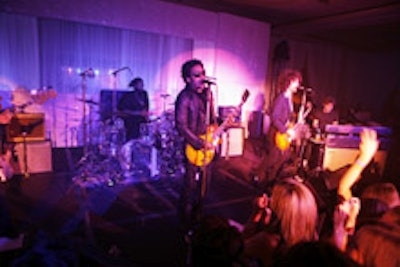
Lenny Kravitz performed at the coed joint after-party.
Photo: Eric Powell for BizBash

Nearly 200 tables filled the Hilton's sunken ballroom for Fight Night, where place settings were simple in black, white, and tan, but darting laser beams set an expectant mood for the eventual boxing matches.
Photo: Eric Powell for BizBash
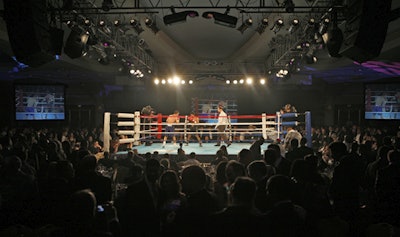
Lightweights Dean "Pit Bull" White and Leo "The Lion" Martinez faced off in the first match of the annual Fight Night, which raised $3 million for children's health and education in Washington.
Photo: Eric Powell for BizBash
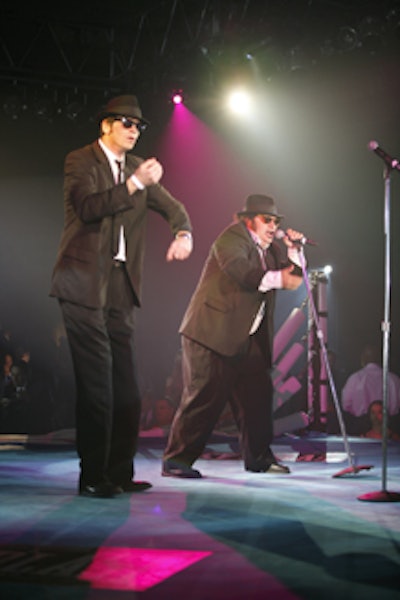
An extended series of energizing performances in the boxing ring—including one by Blues Brothers Band impersonators—geared up the 2,200 guests for the fights.
Photo: Eric Powell for BizBash
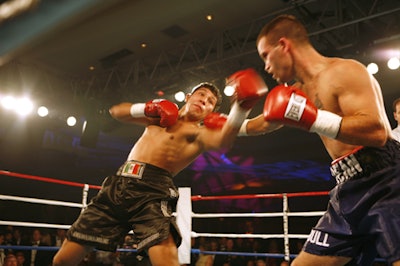
Leo Martinez (left) scored a blow to Dean White as the first of four matches played on five projection screens placed around the ballroom.
Photo: Eric Powell for BizBash
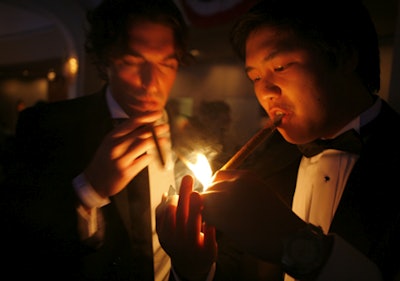
Guests were able to light up at Fight Night, thanks to a last-minute waiver of the city's new smoking ban.
Photo: Eric Powell for BizBash
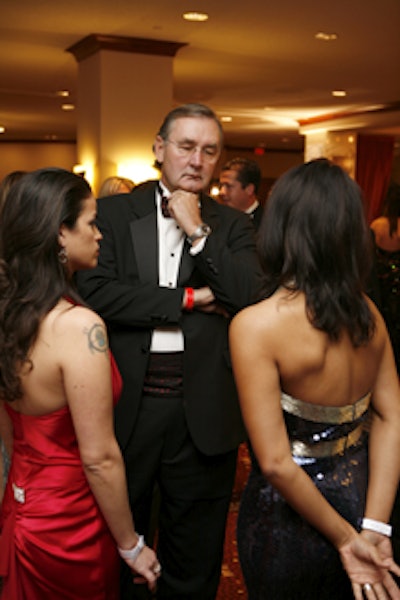
More than 250 models from Howell Management circulated among the mostly male crowd, fetching them cigars and cocktails and politely engaging them in small talk.
Photo: Eric Powell for BizBash
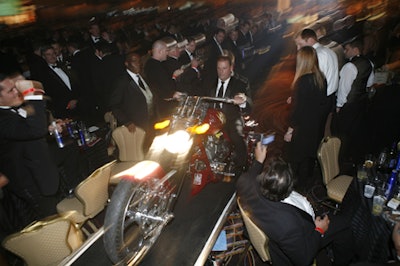
Included in Fight Night's live auction—a complement to its extensive silent auction—was a custom Fat Daddy 330 Chopper signed by the Washington Redskins that revved up a ramp into the boxing ring, fetching $105,000.
Photo: Eric Powell for BizBash
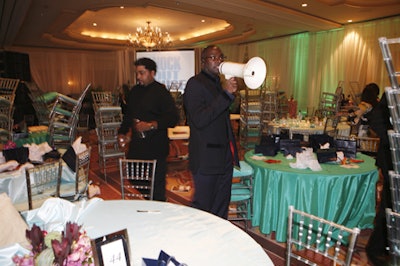
Planner André Wells directed the transformation of the Knock Out Abuse gala dinner to a splashy after-party, while guests waited in a hallway.
Photo: Eric Powell for BizBash
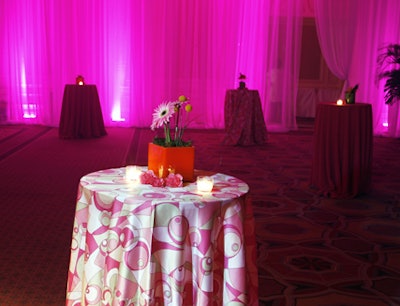
Standing tables swathed in pink and topped with potted gerbera daisies and white votives accented the after-party decor.
Photo: Eric Powell for BizBash
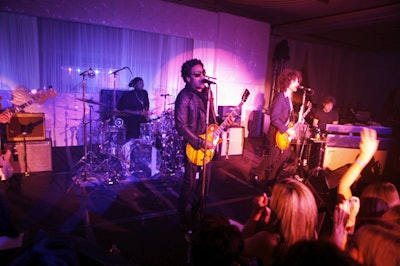
Planners kept the after-party act Lenny Kravitz under wraps until almost showtime, to deter would-be crashers.
Photo: Eric Powell for BizBash
















